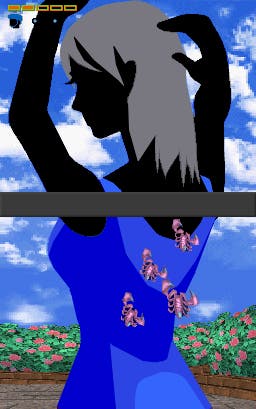Feel the Magic: XY-XX
Taps all the DS's most significant achievements. So what's the rub?
Shop for games now with Simply Games.
This is so obviously a game.
It has been wrongly referred to as a "dating sim". When people say "dating sim" to you (do people ever say "dating sim" to you? They don't to me), it infers that you will be one of the people involved in the dating. You never feel that way playing Feel the Magic. You may be trying to win the heart of a girl, but you're doing it in consistently ridiculous fashion, she never gives you any cause to bother with her besides her (reported) good looks, and who cares anyway because if you have some or any of a bunch of SEGA Game Boy games you can always unlock the ability to change her face and skirt. Besides, she's ours anyway, we've already paid for her once.
Which leaves a game. That assembles stylus and occasionally microphone-based mini-games under the pretence of competing for the affection of a silhouetted young lady. Er, with the help of a group of performers called the "Rub Rabbits", who are often complicit in your wacky schemes.
We like Minis

Still, we have a lot of faith in DS mini-games. Super Mario 64 DS features some wonderful examples that play on all the system's unusual strengths, while Wario Ware, Inc. DS is at the very top of our list of early must-haves, and the entire point of that is short, sharp bursts of game.
Having tied itself to the idea of chasing and courting somebody, naturally most of the tasks that make up Feel the Magic directly involve impressing her, having happened upon her in a crowd and inadvertently knocked a shoal of goldfish down the throat of a passer-by. So the first task has you rubbing quickly in upward strokes on the touch-screen's representation of the man's stomach. Rub aggressively and repeatedly enough and the fish will escape through the mouth on the top screen. Fail to do so and they may sink into the bowel. Complete five increasingly difficult versions of the same task without losing your three, er, "lives" (seems fair; it hasn't really justified any special terminology) and the girl is impressed and you move on.
This very much sets the tone for the rest of the game. Boy and girl somehow come together; boy wants to impress or girl finds herself in trouble; boy performs some feat of comedy/athleticism/heroics/lunacy five times in a row; we move on.
The idea task-to-task is to build up your young target's affection for you in percentage terms - as indicated between attempts - and tasks are often grouped into small sets that represent a "scene", the idea being to complete enough of them (you can repeat the same ones if you like) to fill the meter and open up the next scene. Failure lowers your total. Each task brings with it a little comic cell sequence of explanation, completed tasks are filed away in the "Memories" menu on the start-up screen for individual access later on, and there are occasional standalone tasks and "boss" encounters that are slightly more involved and multi-faceted than the rank and file.
That about covers the framework of the thing, then, and we can be fairly objective about all that: it's a good set-up. Populate it with mini-games borne of enough imagination, and the package sells itself. It'll be like Wario Ware's come early.
But it's not quite there. It's like the mini-games in Mario 64 DS in a sense; most of them are really clever, or really entertaining, and deserve to be played, but others are just silly novelties that either wear off or reveal themselves to be tedious, frustrating, or poorly balanced. There's not enough greatness here for it to be a great game.
Kinds of magic

Some examples, then. Parachute: there's a plane flying along the top screen and your Rub Rabbit chums are leaping out of it one by one. When each one jumps a little number is tagged onto him, and your job is to use the calculator-style number pad display on the bottom screen to quickly tap in the number in order to open the parachute. As it gets harder the number of jumpers increases and the numbers themselves get longer, making it more difficult to keep track. Simple and clever.
Monocycle: the idea is to guide your little man on what we always thought was called a unicycle across narrow walkways between rooftops. You do this by dragging him along with the stylus and not allowing your stylus tip to stray outside the lines. Some bits are narrower than others, and the timer - initially not much of a concern - becomes more of a hassle as the ante is upped by twistier and turnier walkways. If we hadn't used a "buzz bar" comparison in last week's Kururin Squash review we'd probably drag that out too to try and illustrate it.
Dance: it's Space Channel 5, except instead of using the D-pad and face buttons you're using a similar representation on the bottom screen to match your partner's "up-up-upupup" and the like. And we do mean "it's Space Channel 5"; we'd swear even the sound effects are the same.
Yacht: one of the few that makes good use of the microphone. The idea is that she's fallen out of your boat, and you have to blow gently into the microphone in order to propel the boat forward far enough to fish her out. If you go too far, you fail, and there are roaming sharks to worry about too.
Steal: a latter task and one of the most puzzly. Your Rub Rabbit friends are trying to sneak into a compound, and there are guards pointing search beams along their prospective path, which is indicated by a red line. The Rub Rabbits follow this like Lemmings, so your job is to tap the stylus on any of four cats - yes, cats - located in the centre of the top, left, right and bottom of the screen in order to distract them so they turn their beams that way. The object, naturally, is to have them face the wrong way at all the critical points so that the Rub Rabbits can make it through unscathed.
One of the boss encounters, dubbed "Drive", is another example of Feel the Magic rubbing us up the right way. You're on a multi-lane carriageway and you use the stylus to turn a steering wheel on the bottom screen to move between each lane. The idea, besides avoiding other road users, is to gather up pedestrians, who are mysteriously legging it along in the same direction, and use a catapult-style chucker to hurl them at the enemy you're pursuing. So you're constantly switching lanes and pulling back on the catapult lever to sling enemies. And it works very well.
Rubbing it in

Most of the games that we like in Feel the Magic (in fact, most of the games full stop) could be worked onto a D-pad/face buttons style controller with consummate ease. But somehow they're more fun like this. Using the stylus (and you have no choice here, as there's no alternative control option) is more than just a novel change. It makes things trickier, and somehow more satisfying.
It's not all good though. Some of the games really are just novelties. Candle is an early effort, admittedly, but really does just consist of puffing your lungs out into the microphone to try and blow candles out. Antlion, meanwhile, has you doing the upward-strokes trick again but this time the goal is to help various hapless individuals escape a quicksand-like pull that's dragging them into the jaws of a nasty bug. It's not much fun. Then there's Hands, which involves using your stylus like a prosthetic hand to clasp hers and swing from side to side as she walks, occasionally pausing to tap on bees that swarm around her head.
It's also a bit distressing that after blitzing through lots of multi-task scenes in virtually no time at all, a couple of tough boss fights hold you up for some time. One, involving the twin tasks of dodging tentacles and chucking bombs into the mouth of a giant plant, took a lot of patience to overcome, and felt slightly unbalanced given what had come before. We were also a bit upset to see that as you close in on the end of the game, it starts to recycle things. One of the very last battles involves completing three boss fights, including the abovementioned plant pain, in a row, and stumbling even at the final hurdle (as we did on one occasion) is enough to mean you have to do them again. It's not the challenge that upset us, more the fact that the first two tasks felt so easy anyway that having to complete them on every subsequent attempt was time-consuming and tedious. Hardly "Magic".
That said, Feel the Magic is still decidedly more enjoyable than it is frustrating or tedious, so much so that we're deliberately not mentioning some of the very best games in the hope that you'll encounter them yourselves, and ultimately there's only one thing stopping us from marking it higher, and that's the problem of it being over so quickly. You do unlock harder versions of each scene when you finish the initial run, which provides a decent spurt of extra challenge, and the unlockable clothing extras give completists something else to work towards. But even so it's not a game that's going to last more than a few days, if that, in your DS card slot.
Stylus-tic
On the other hand, it does demonstrate better than either Super Mario 64 DS or Metroid Prime Hunters that the DS has something different to offer, and that directing matters with the stylus can be more than just a novelty or a reinvention of the wheel. It can make a discernible difference to the way you appreciate the game you're playing, and on the basis of this and the evidence in Mario 64's mini-game collection, the DS is a console that's going to be brilliant at providing short, sharp thrills, whatever the quality of the more traditional game design aimed in its direction.
In other words, it's so obviously a lot of good games. And we're feeling a degree of magic. But in the end Feel the Magic isn't quite enough to sate us.
Shop for games now with Simply Games.








